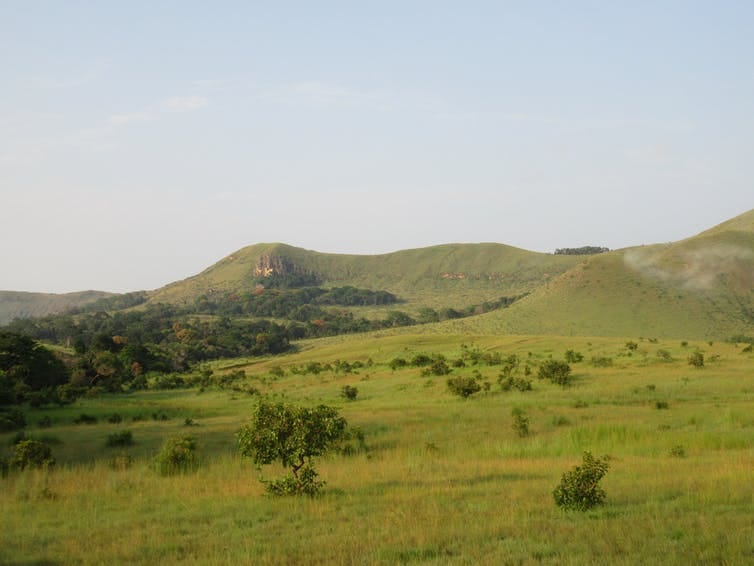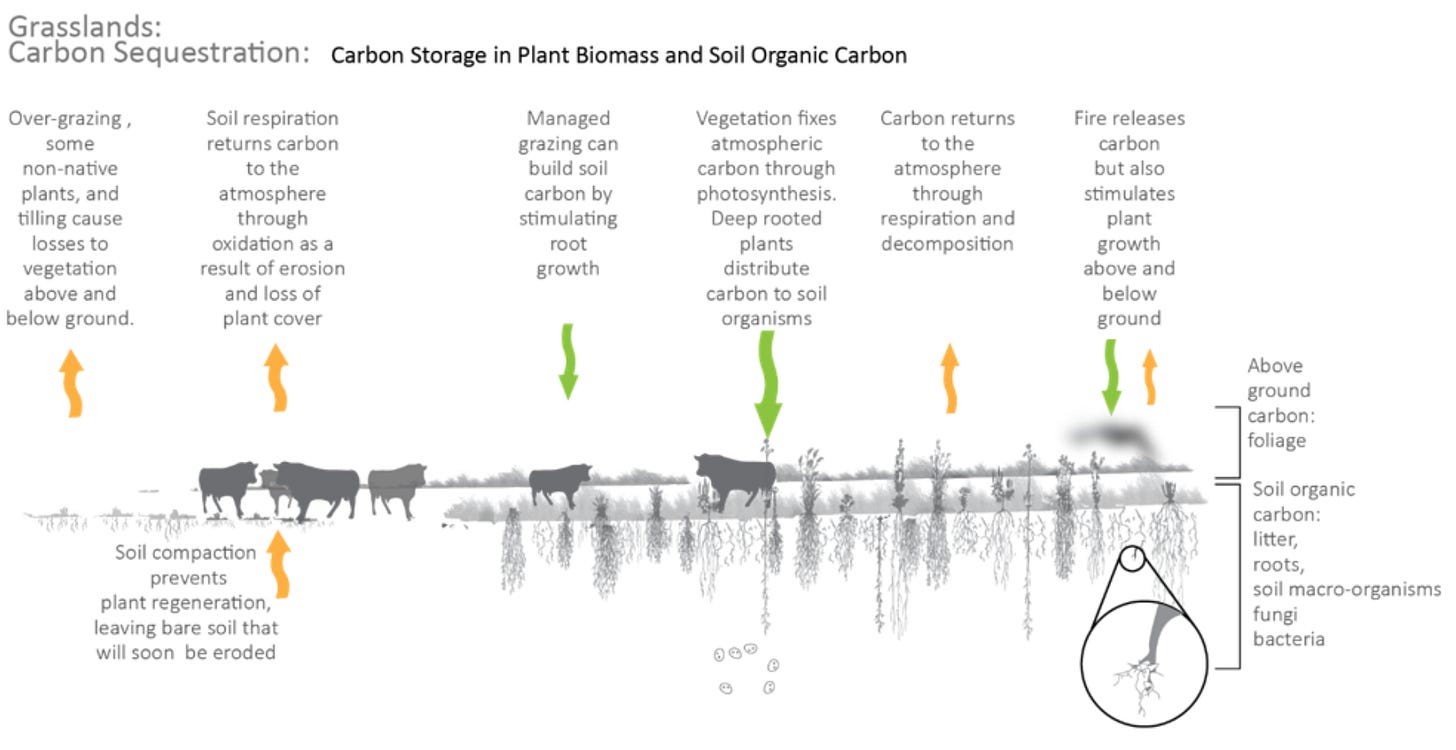Grasslands: A more reliable carbon sink in the 21st-century
Welcome back to The Regeneration Weekly, a newsletter delivering regenerative food and agriculture news to your inbox every Friday. Not a subscriber yet?
Policy: Across the globe, forests have historically served as a carbon sink, absorbing nearly a quarter of the carbon dioxide (CO₂) emitted by human activities. Therefore, more forests may sound like a good thing, especially given the rising levels of atmospheric CO₂ and deforestation around the world. However, the worsening of climate change has turned reforestation into a double-edged sword - undoing the problems it set out to solve. In short, when trees sequester CO₂, the gas doesn’t disappear forever: The plants simply store the carbon, incorporating it into their woody biomass and leaves as they grow. And when trees are ultimately harvested for wood products or destroyed by natural disasters, the accumulated carbon is re-released back into the atmosphere.
With this in mind, it’s dangerous to confuse climate restoration with simply adding industrial forests to an ecosystem. Afforestation projects (planting trees in areas that have never been forested), in particular, often consist of fast-growing species like pine and eucalyptus, which are highly flammable. This decision does not bode for the future when, across the globe, decades of fire suppression, rising temperatures, and drought have increased the risks of wildfire - transforming forest growth campaigns from carbon sinks into carbon emitters. And as private and public stakeholders plant millions of saplings to offset their carbon emissions, new research suggests that trees in the tropical, temperate, and upland forests can leak both methane and nitrous oxide. Moreover, by 2040, if global temperatures continue to rise at the current rate, forests will take up half as much CO₂ as they do now - potentially losing more carbon than they accumulate.
To make matters worse, as a global regime advocates for ‘wall to wall’ planting of tree plantations, grassy ecosystems (grasslands, rangelands, savannas, shrublands, and meadows), which cover between 20 to 40 percent of the world’s land surface, are at risk. Proponents of afforestation falsely assume that grassy biomes that were never forests are in need of trees. However, reports from South Africa, Australia, China, and Brazil highlight how adding non-native tree species negatively alters the functioning of ancient grasslands - deteriorating the health of freshwater systems and producing a net loss of biodiversity. And for those that view grasslands as unproductive, it turns out that they contain massive reserves of biodiversity and can store up to 30 percent of the world’s carbon in their plants and soils. Globally, soils can store between 1.5 to 5.5 billion tons of carbon a year - more than is contained in all the Earth’s plant biomass.
Carbon in soil builds up over millennia through a complex process that starts with photosynthesis. A plant absorbs carbon out of the atmosphere and returns to the soil what isn’t utilized in the form of residue and root secretions. This system feeds microbes in the soil. The microbes transform it into the building blocks of soil organic matter (SOM) - helping to stabilize the carbon. This protected carbon builds up as long-term “carbon stocks” with different permanence. Unfortunately, the physical disturbance of planting and the input of fresh organic matter from new saplings can disrupt the microbial community belowground, making the soil microbes hungrier for organic matter. In doing so, research has revealed a 10 percent decline in soil carbon stocks when grasslands are converted to forest plantations. In the wake of botched initiatives focused on indiscriminately planting trees, many ecologists now express what they view as a lack of prioritization for the world’s grasslands, which can:
Reliably store carbon: Unlike forests, grasslands sequester a majority of their carbon underground, where it is stored safely for centuries to come. And new reports reveal that in a warming world, treeless, grassy biomes can store even more carbon than forests because they are less vulnerable to fire, drought, and disease. When fires do burn grasslands, the SOC is well protected because it is buried deep in the soil. In fact, low-intensity fire, which is a normal disturbance to grassy ecosystems, causes the oxidation of organic carbon while simultaneously stimulating root growth and increasing organic matter additions to the soil. And if atmospheric CO2 doubles pre-industrial levels, researchers estimate carbon uptake in grassland soils will increase 8 percent while carbon uptake by forest soils will remain flat.
Enhance agroecosystems: In developing countries, farmers are often encouraged to substitute biodiverse agroecosystems with man-made forests. But in the US, scientists estimate that domestic rangelands - commonly grazed by livestock - could sequester up to 330 million metric tons of carbon dioxide in their soils, equivalent to 70 million cars driven for a year. And this doesn’t even include the potential benefits of good land management, such as holistically managed grazing, to boost soil health, stimulate root growth, and increase carbon stocks in the 770 million acres of rangelands nationwide. To help incentivize conservation practices, new companies like Grassroots Carbon have cropped up to connect regenerative graziers to carbon credit opportunities. In short, ranchers can now be paid to store carbon and preserve grassy ecosystems.
By reorienting our focus from planting forests to maintaining grasslands, we can reap the rewards of healthier soils, which can grow more food, hold more water, break down pollutants, prevent erosion, etc. And from a carbon offset perspective, monetizing grazing practices that store reliable rates of carbon could more effectively meet states' or companies' emission-reduction goals while providing a better livelihood for millions of ranchers across the globe.
Listen: In this episode of STEM-Talk, Allan Savory sits down with co-hosts Robb Wolf and Ken Ford to talk about the global importance of restoring the earth's grasslands. Savory is an ecologist and the president of the Savory Institute, which promotes large-scale restoration of the world’s grassy ecosystems through holistic management.
Shop: Father's Day is this weekend, but it's never too late to treat dad to Wholesome Meats' regeneratively raised grass-fed beef. Send dad his favorite steaks, or their Grilling Essentials Bundle, which includes 2lbs of ground beef, 2 6oz filets, and 2 12oz boneless ribeyes. Take 15% off until June 20th with the code “FATHERSDAY15” at checkout.
Disclaimer: The Regeneration Weekly receives no compensation or kickbacks for brand features - we are simply showcasing great new regenerative products.
The Regeneration is brought to you by Wholesome Meats | Soilworks | PastureMap.







That's my photo you are using there. Taken from this article: https://theconversation.com/when-tree-planting-actually-damages-ecosystems-120786
Hi Parker, thanks for this article! Curious to know - do you know how many tree planting or carbon offsetting projects are planting trees in forests that have become forests on converted grasslands? Implication if a lot would be most 'tree-planting' projects (esp companies that promise to plant x amnt of trees for certain purchases) are actually not as helpful as they may seem.